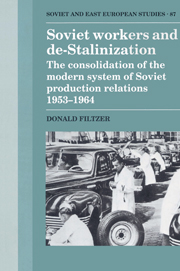 Soviet Workers and De-Stalinization
Soviet Workers and De-Stalinization Book contents
- Frontmatter
- Contents
- List of tables
- Preface and acknowledgements
- List of terms and abbreviations
- Introduction: the contradictions of-Stalinization
- Part I Labour policy under Khrushchev: issues and results
- Part II De-Stalinization and the Soviet labour process
- Conclusion
- Notes
- Bibliography
- Index of industrial, mining, and construction enterprises
- General index
- Soviet and East European Studies
Introduction: the contradictions of-Stalinization
Published online by Cambridge University Press: 29 January 2010
- Frontmatter
- Contents
- List of tables
- Preface and acknowledgements
- List of terms and abbreviations
- Introduction: the contradictions of-Stalinization
- Part I Labour policy under Khrushchev: issues and results
- Part II De-Stalinization and the Soviet labour process
- Conclusion
- Notes
- Bibliography
- Index of industrial, mining, and construction enterprises
- General index
- Soviet and East European Studies
Summary
When Stalin died in March 1953, he left behind a country in a deep state of crisis. No sphere of the economy, politics, or society was immune. The economy, despite its rapid recovery from the ravages of World War II, was in considerable difficulty. The crisis was most glaring in agriculture, which was poorly mechanized and unable to provide the country with more than the most basic foodstuffs. Industry, though not in the same obvious state of decline as the countryside, continued to suffer from the structural weaknesses created by Stalinist industrialization: management was overcentralized and top-heavy; productivity and technology lagged badly behind those of the West; and production of consumer goods was woefully inadequate. In 1952, light industry produced just three pairs of socks or stockings for each member of the population, and barely more than one pair of shoes. Consumer durables such as refrigerators or television sets were virtually unobtainable. But the pitiful economic realities were themselves symptomatic of a more profound political demoralization affecting the Soviet population. The terror and the network of labour camps on which the Stalinist system had so heavily depended had clearly outlived their usefulness. Not only was it clear that the population could no longer be expected to accept the strain under which the terror placed them, but the camps themselves were becoming increasingly difficult to control and manage, as evidenced by a growing number of rebellions.
It did not require a profound understanding of the political economy of the Stalinist system to recognize the direct relation between the population's discontent and the economic impasse.
- Type
- Chapter
- Information
- Soviet Workers and De-StalinizationThe Consolidation of the Modern System of Soviet Production Relations 1953–1964, pp. 1 - 10Publisher: Cambridge University PressPrint publication year: 1992
